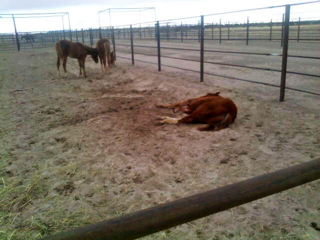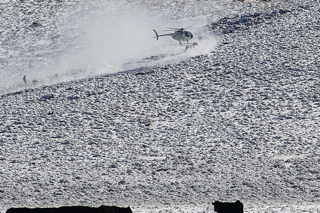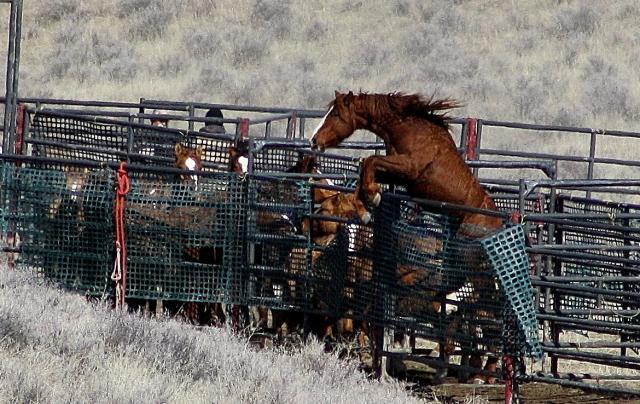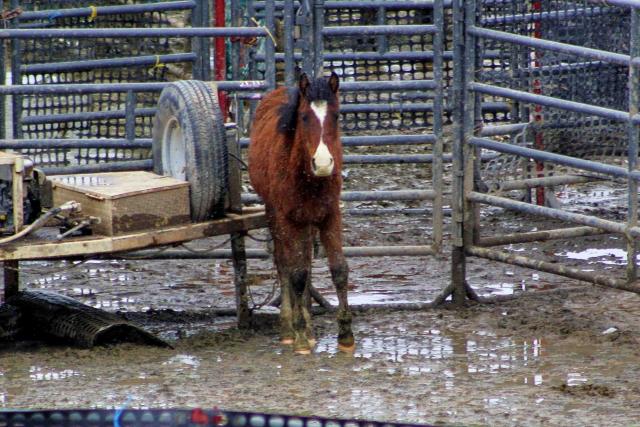You learn many interesting things traveling on public lands following the wild horse issue in the American West.
You learn that after standing in sub-zero temperatures, attempting to document winter roundups, that returning to the relative warmth of your parked vehicle can make your glasses crack. You learn that chemical toe warmers are good as wrist, neck and “slip into your coveralls attach to your underwear” warmers as well. You learn that rattlesnakes don’t always rattle.
You learn the maneuvers the federal government will attempt to hide their actions when “managing” America’s wild herds: Maneuvers that range from lying about facility contracts to a roadblock on a remote dirt road operated by armed men who stop three woman from seeing the wild horses being captured.
On June 19, 1971 both houses of Congress passed the Wild Free Roaming Horse and Burro, act without a single dissenting vote. That act read:
§ 1331. Congressional findings and declaration of policy
Congress finds and declares that wild free-roaming horses and burros are living symbols of the historic and pioneer spirit of the West; that they contribute to the diversity of life forms within the Nation and enrich the lives of the American people; and that these horses and burros are fast disappearing from the American scene. It is the policy of Congress that wild free-roaming horses and burros shall be protected from capture, branding, harassment, or death; and to accomplish this they are to be considered in the area where presently found, as an integral part of the natural system of the public lands.
Somehow though, somewhere in the implementation of the Act, something went terribly wrong. In its findings, Congress declared, “These horses and burros are fast disappearing from the American scene.” However the agency tasked by Congress to protect and preserve these disappearing horses became transformed into a machine that removes more horses from public lands than any other force or man or nature in modern history.
As a journalist and photojournalist, this issue has become my life’s passion. Yet the pursuit of the story has now taken me to the Ninth Circuit Court of Appeals to protect my First Amendment right to document and report the actions of our government in this issue of great public interest.
If there is nothing to hide, why go through such lengths to hide what is being done? This is hardly a matter of national security, after all.
 This doomed wild horse, stampeded for miles by BLM helicopter "cowboys," has literally lost its hooves (photo by Laura Leigh)
This doomed wild horse, stampeded for miles by BLM helicopter "cowboys," has literally lost its hooves (photo by Laura Leigh)
This courtroom saga began last summer, when the BLM announced a broad public land closure prior to a roundup in the heat of the July desert. The bureau tasked with humane management of our wild herds was preparing to execute this operation during actual foaling season in the area. My attorney, Gordon Cowan of Reno Nevada, filed suit in the Federal District Court seeking to block the action.
The issue of foaling season was never heard, because the BLM presented a document, dated the day of court hearing, declaring an unprecedented water emergency. They made a claim in the courtroom that 75% of the horses would be dead in three days if the Court granted the relief sought. The court dismissed the motion based on the claimed emergency, so the issue of newborn foals being run in the desert heat unheard.
Yet the Federal District Court Judge, the Honorable Larry Hicks, did order the land closure lifted as a prior restraint to the First Amendment.
Traveling overnight to reach the range before the chopper flew at dawn was exhausting. My head throbbed, as I had suffered a concussion from being rear-ended by a drunk driver just a week earlier.
 BLM contractors use helicopters, flying low to the ground, to frighten and stampede wild horses (photo by Laura Leigh)
BLM contractors use helicopters, flying low to the ground, to frighten and stampede wild horses (photo by Laura Leigh)
We arrived in the pre-dawn hours to begin a cat-and-mouse game of conversations that claimed compliance with court orders, yet threatened arrest. The district manger for the BLM, Ken Miller, even went so far as to say there “was nothing to see,” after an emergency was declared that was so extreme it topped anything in the district’s history.
When we got near the trap site we were met with a roadblock staffed by armed men. We were told if we went further we were trespassing and subject to arrest. There were no signs and the BLM map did not have private roads listed. We retreated.
Later I discovered the road never actually turns private. The boundary to private property was a considerable distance up the public road. Not a single horse was viewed by members of the public during capture or at the temporary pens.
These “access games” are compounded, convoluted and repeated. Discriminatory access was given to members of the press whom BLM felt worthy, even as I was barred access to the same site. Not only was I denied access, but I was ordered to move away from public land when I attempted to photograph a truckload of horses on a public road.
 Trapped wild horse caught trying to escape its cage (photo by Laura Leigh)
Trapped wild horse caught trying to escape its cage (photo by Laura Leigh)
Another suit was filed that addressed the obscenity of the department-wide lack of transparency. Roundups occur without public notice by the Fish and Wildlife service (also under Department of Interior). A facility the BLM closed to the public (with the BLM claiming it was never intended to be open to the public, even as internal emails reveal the closure was because of damage done to the agency’s reputation by the reports that were published after such visits), actually has a rule that allows weekly tours until 2015. Violations of the act, ranging from the most basic management of the range, to actions during capture, holding or during sale, are kept hidden from public view.
Now the court has held off on making a decision on a request for emergency injunctive relief until more than six months after the motion was filed. The court cited “mootness,” because the roundup was over.
“Public debate is vital to any Democratic process,” states attorney for plaintiff Cowan. “If the information utilized in debate is subjected to content control the debate is moot, not the argument.”
Amicus briefs have been filed by the Reporters Committee for a Free Press and by the National Press Photographers Association in this landmark case about the public’s right to know.
 Terrified and sweaty from being stampeded, a young wild colt cowers in the trap (photo by Laura Leigh)
Terrified and sweaty from being stampeded, a young wild colt cowers in the trap (photo by Laura Leigh)
July 1 roundups are about to begin again during another foaling season. Pregnant mares and newborn foals will once again be run in the desert heat by the agency tasked by Congress to manage them as an integral part of the landscape.
Will the public actually have meaningful access to witness the hands-on management of a National Treasure by our government? We will see very soon.
To learn more about the lawsuit and read pertinent documentation go to: WildHorseEducation.org
LAURA LEIGH is a journalist/photojournalist focusing on issues of the American West. She also serves as wild horse expert for several equine welfare agencies. Laura can be reached through WildHorseEducation@gmail.com This article was written for ThisCantBeHappening!
_____________________________
Addendum:
Another Sad Story of Greed and Slaughter Not Being Reported
By Marilyn Wargo
This summer the federal Bureau of Land Management, which overseas most of the nation’s federal lands, intends to take approximately 10,000 more horses from their legal, designated ranges in Western states. Beginning July 1st there will be roundups in Nevada, Wyoming and Oregon and later in Colorado.
This huge removal number is likely to represent two-thirds of the remaining wild horses living on public lands. We will have almost nothing left of these herds by this coming November.
Many of these animals will die, along with a piece of America.
The BLM claims there are 36,000 wild horses on public lands but those wild horse advocates who have been out in the field compiling the numbers removed and the numbers left after round-ups realize, as usual, that BLM plays fast and loose with such numbers. This is something the agency has been criticized for even by the Government Accounting Office, state representatives and U.S. senators.
This numbers game explains how the BLM can remove more animals than allegedly “intended,” and at the same time actually succeed in “zeroing out” from what is called — at least while there are still wild horses there — a Horse Management Area (HMA).
We have lost over 100 HMAs that have now been “zeroed out,” and over 20 million acres of designated wild horse and burro range has been taken by the BLM for conversion to other uses. It’s all about private industry displacing wild herds.
The scheme works like this: First the BLM shrinks in size, on paper, the area where horses live. Then it determines the HMA to have an “excess” population of wild horses on the newly reduced territory. The “excess” horses are subsequently removed in tortuous roundups. Thousands of sheep and cattle, mines and energy projects–all owned by commercial interests that grease the palms of the political machine — then replace the horses, despite a federal law declaring that the horses are to have priority on their designated rangelands.
“Multiple use” implies that the Horse Management Areas must allow other uses, but in practice, the wild horses are never the primary management concern as they are meant to be under the 1971 Wild and Free Roaming Horse and Burro Act. Rather, they are considered last and are removed to make more land available to these other more lucrative interests.
Removing the horses is illegal, but in practice, private industry– particularly the ranching interests–have been given free rein on many HMAs. Basically, anything goes when it comes to stealing these lands from the horses.
There has been no compensation for the destruction of the horses and little headway made to check the illegal removals by BLM. Wild Horse Advocates are trying to change this. Laura Leigh is our foremost advocate in the field.
The issue of wild horses and their removal from designated HMAs has for some time been one of the top ten subjects the White House receives phone calls on. These calls come in from the thousands of people who have heard about the systematic loss of our wild herds. Many are horse people but many more just love the idea we still have wild horses and want them saved and protected. More people are becoming aware of this scandal daily.
Since the economic slump, the American media have left many urgent stories by the wayside. This is one.
Some of the cattle that get moved onto the HMAs are owned by the corporations who have leased cattle allotments inside the HMAs where the cattle and sheep can eventually outnumber wild horses and burros by factors of more than 200 to one.
The BLM is also selling off thousands of acres of public lands. Little investigation has been done into this rape of the West and there has been no public accounting of the loss to taxpayers. Transparency is nonexistent. The response to public outrage is to hide everything as much as possible from critics, investigators and observers like Laura Leigh.
Many horses of all ages are killed during these roundups– especially vulnerable young animals.
No tally is kept of the number of animals left to die on the range from injury or dehydration. In fact, foals are not even counted until they are at least four months old and unless they have been weaned. Many foals die from the forced runs driven by helicopters flying low to the ground. Horses have been known to run 10 miles or more, and observers fear they have been forced to run up to 20 or more miles before reaching the trap site. If the average citizen did to these horses what the BLM does routinely, they would be arrested and thrown in jail. The animal abuse issues are also growing and many new advocates have taken up this aspect of the crisis.
New management is needed. The BLM is violating to the law and instead of protecting it is destroying our national heritage.
MARILYN WARGO is a horse professional certified in Equine Science. She is also an award-winning photographer who studied with Shelby Lee Adams, a journalism graduate of New Mexico State University and a longtime wild horse and wildlife activist who lives in the San Juan Mountains of Southern Colorado. She wrote this article for ThisCantBeHappening!
